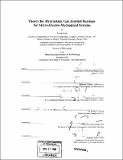Theory for hydrostatic gas journal bearings for micro-electro-mechanical systems
Author(s)
Liu, Lixian, Ph. D. Massachusetts Institute of Technology
DownloadFull printable version (51.92Mb)
Other Contributors
Massachusetts Institute of Technology. Dept. of Mechanical Engineering.
Advisor
Zoltan S. Spakovszky.
Terms of use
Metadata
Show full item recordAbstract
The goal of the MIT micro-engine project is to develop high-speed rotating Power MEMS (Micro-Electro-Mechanical Systems) using computer chip fabrication technologies. To produce high power (10-50 W) in a small volume (less than one cubic centimeter), the micro-turbo-machinery must be spun at a rotational speed on the order of million rpm. This ultra-high rotational speed, together with the small length-to-diameter ratio (L/D<0.07) limited by the chip manufacturing technology, entails many challenges in the design of the bearing system, such as an ultra-high whirl ratio of over 20 (compared with a whirl ratio of 2 for large-scale journal bearings) and a DN number of order 10 million mm-rpm. The thesis presents a newly developed theory for the hydrostatic gas journal- bearings for the micro-engine devices. To investigate the underlying physical mechanisms, fluid models are established to analytically calculate the hydrostatic, hydrodynamic, and damping bearing forces. It is found from first principles that the hydrodynamic force due to viscous drag becomes dominant with an L/D<<1 and acts in the opposite direction of the hydrodynamic force due to rotor pumping action. (cont.) As a result, the net destabilizing hydrodynamic force can vanish for certain bearing geometries, causing singular behavior in the whirl instability limit. Thus, the ultra-short bearing is suggested to enable a large DN number and a high whirl ratio in the micro-journal-bearing system. A novel variation of the axial-flow hydrostatic micro gas journal-bearing concept is introduced, which yields anisotropy in bearing stiffness. By departing from axial symmetry and introducing biaxial symmetry in hydrostatic stiffness, the bearing's top speed is increased and the fabrication tolerance requirements are substantially relieved. The third-order nonlinear resonances in the micro-journal-bearing system are investigated by both analytical models and numerical simulations, and the predictions from these models agree well with the experimental observations. The model predicts a subharmonic resonance in the isotropic journal-bearing system, with a slow rotating noncircular orbit such that the symmetry of the system is broken by itself in the nonlinear resonance. (cont.) Furthermore, the anisotropic journal-bearing system is found to be able to engage in multi-type nonlinear resonances: superharmonic resonances at one third of the natural frequencies, subharmonic resonances at three times the natural frequencies, and combinations (such as the average) of the two natural frequencies. The conditions under which these resonances can occur are derived analytically and are then verified by numerical simulation.
Description
Thesis (Ph. D.)--Massachusetts Institute of Technology, Dept. of Mechanical Engineering, 2005. "September 2005." Includes bibliographical references (p. [281]-283).
Date issued
2005Department
Massachusetts Institute of Technology. Department of Mechanical EngineeringPublisher
Massachusetts Institute of Technology
Keywords
Mechanical Engineering.